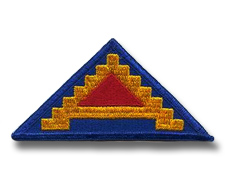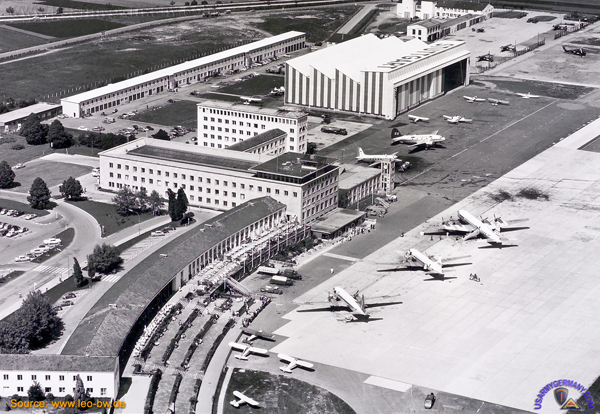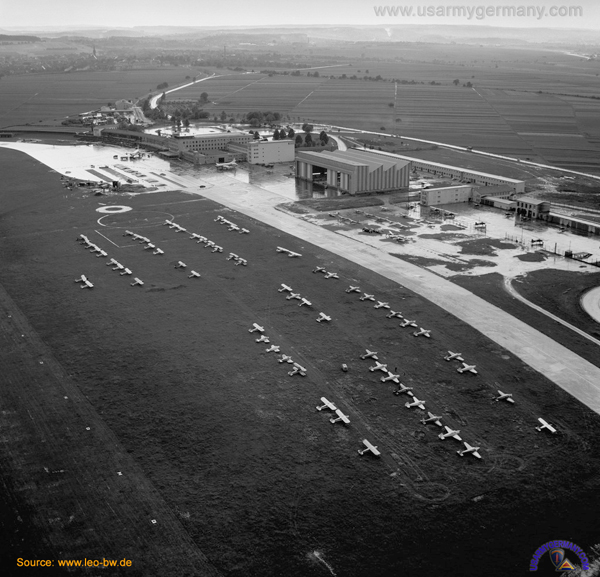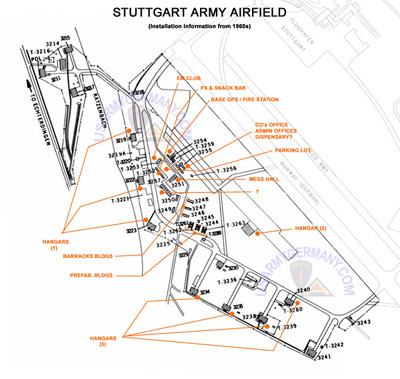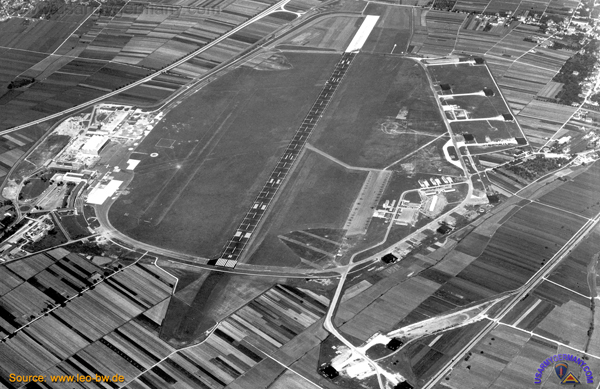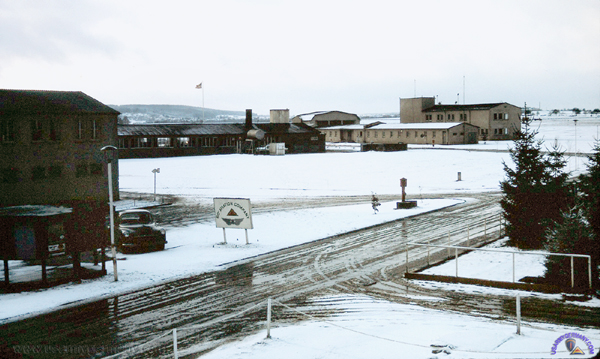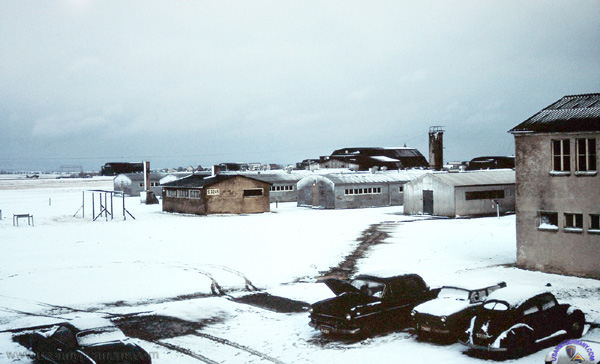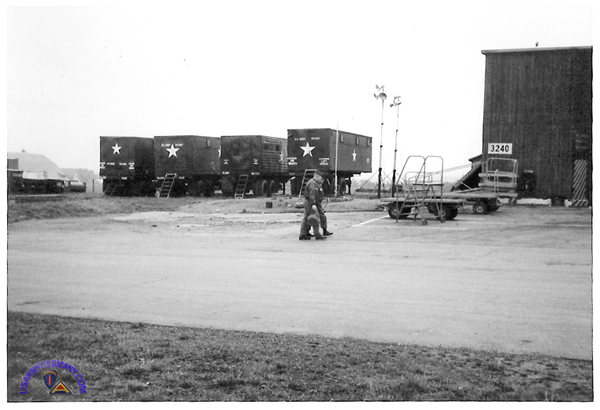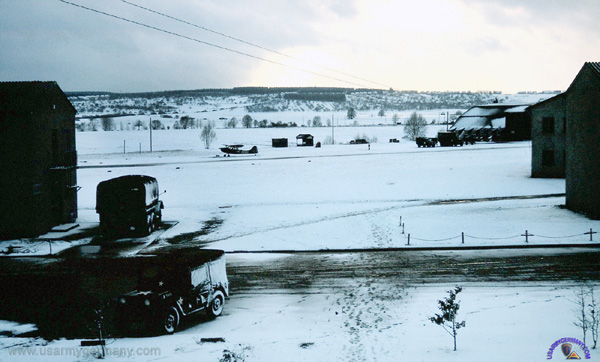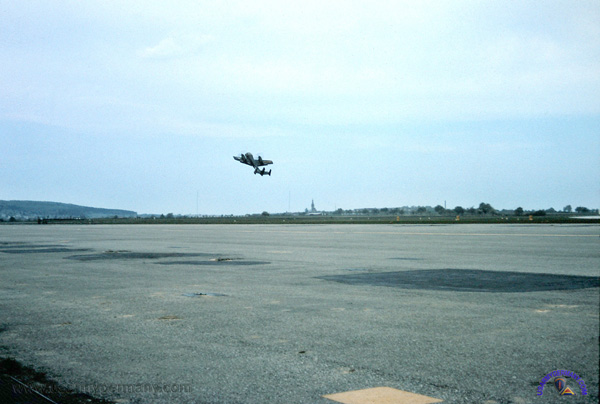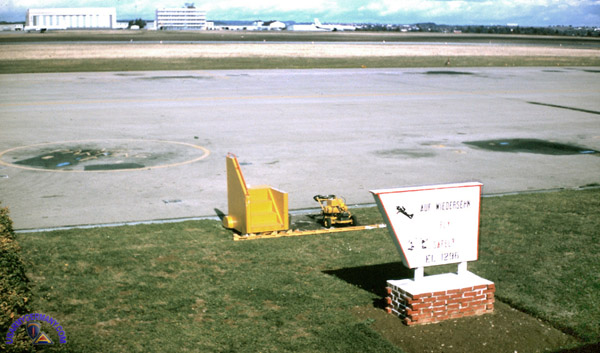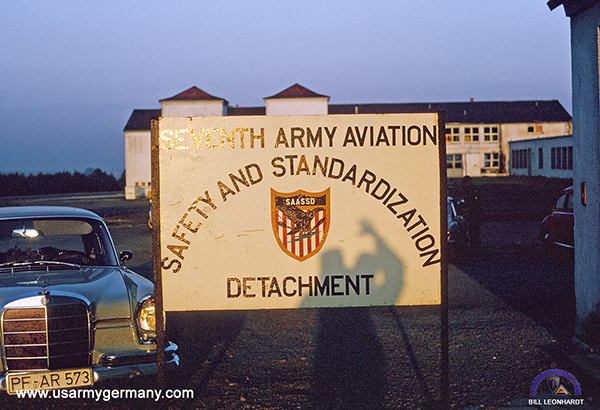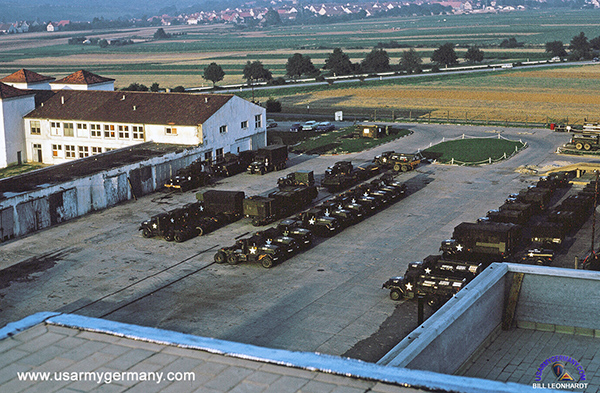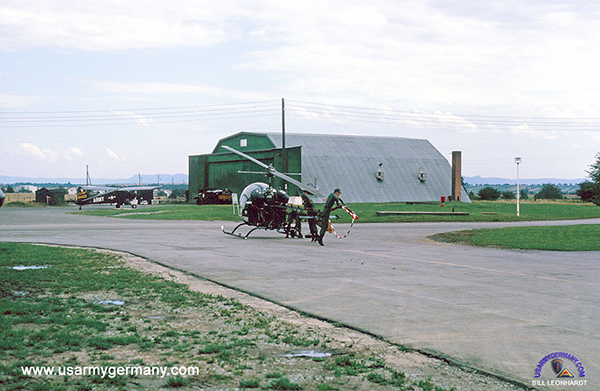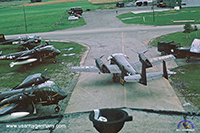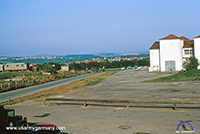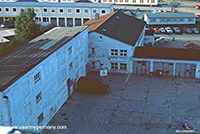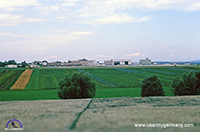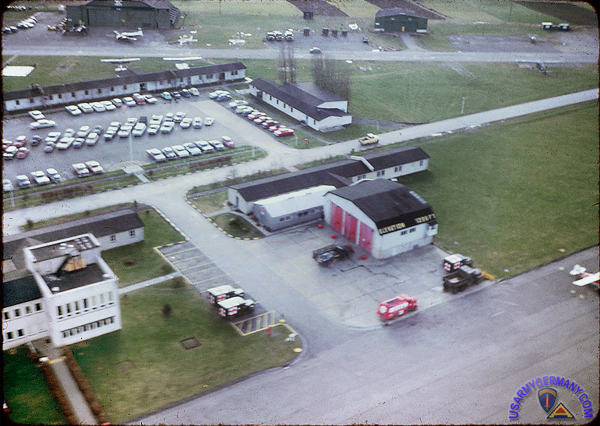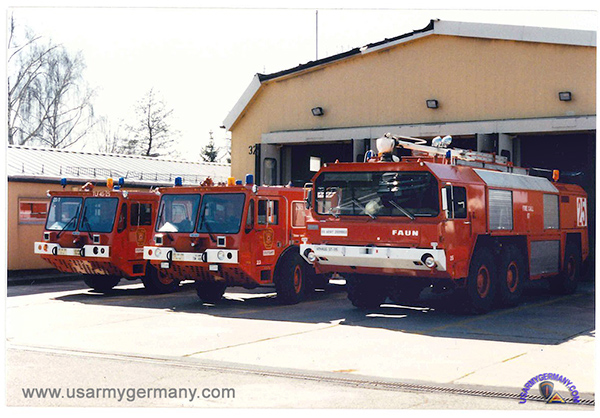| If you do
NOT see the Table of Contents frame to the left of this page, then
Click here to open 'USArmyGermany' frameset |
|||
|
Stuttgart Army Airfield |
|||
|
|
|||
|
|||
|
|
|||
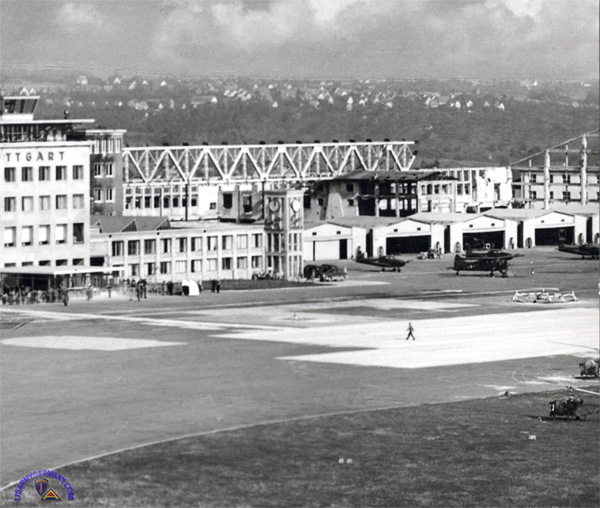 Stuttgart Army Airfield - civilian side, probably early 1950s |
|||
| History | |||
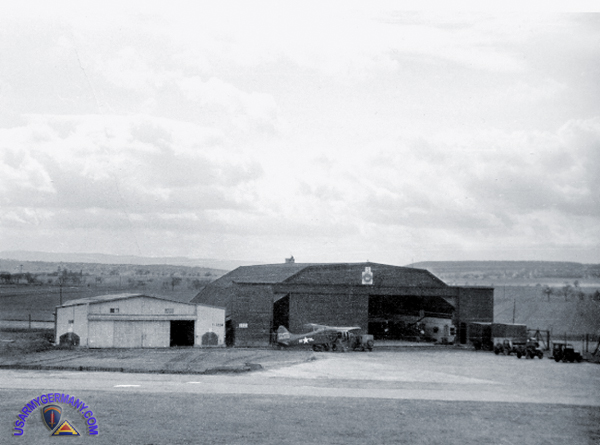 Hangar 6 at Echterdingen, 1956 (Andy Graybeal) |
|||
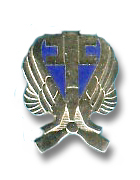 223rd Aviation Bn DI 223rd Aviation Bn DI |
|||
| 1945-67 | |||
| (Source: Globesecurity.org) | |||
First French Army occupied the Echterdingen Flugplatz (originally constructed between 1936-38) in April 1945. American troops replaced the French Army in the early summer and put the airfield back into operation. German civil air operations started up again at Echterdingen in the fall of 1948. In the spring of the next year the Flughafengesellschaft (FSG), the corporation that owns and operates the airport, arranged to share the U.S. Army apron and other facilities on the north side of the runway. Military flight operations changed markedly in the spring of 1967 when the flight section of Headquaters, U.S. European Command arrived from Paris, France (FRELOC). |
|||
| 1958 | |||
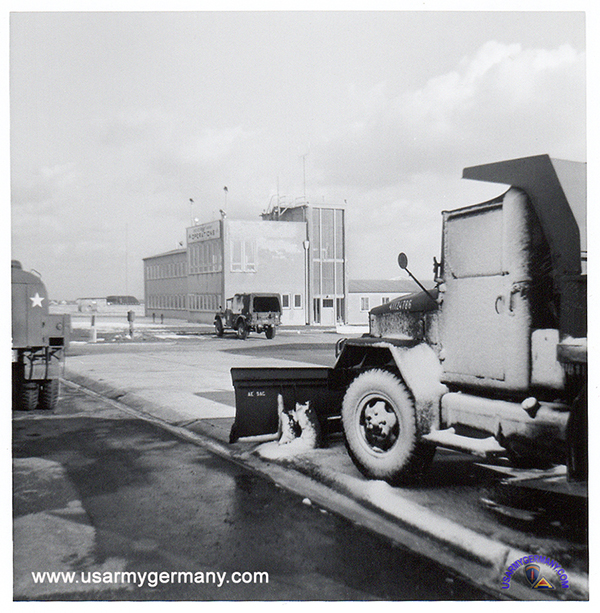 Operations Building, Stuttgart Army Airfield, 1958 (Webmaster's collection) |
|||
| 1963 | |||
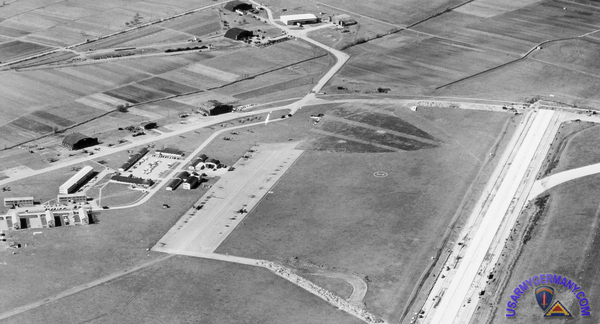 Stuttgart Army Airfield in 1963 (www.leo-bw.de) |
|||
| Webmaster note: at the time this photo was taken, construction work was being done on the runway (right). | |||
| (Source: Email from Thomas Ritter) | |||
| I was stationed at Echterdingen Army Airfield from August 1963 to September 1965 as a member of the 60th Aviation Company. I bunked in Building 3248 for a few weeks, than was moved over to the quonset huts (T-3261) for the rest of my tour. I worked out of the fixed wing hangar #3222. You have a great picture of this in your "60th Avn Co" section. When the picture was taken (December 1963), I was probably sitting at my desk next to the third window from the back. Incidentally, those are two of our DeHavilland U-6A "Beavers" parked out front -- arguably one of our best fixed wing aircraft at the time. The 60th had at least one rotary wing hangar. This was in the southeast area, and may have been either 3230 or 3234. We also used a hangar down by the main gate -- possibly 3215. In addition to the aircraft you list, the 60th also had several Cessna O-1As, several Bell OH-13s, and a few Sikorsky UH-34s. As I recall, we had both a U-8F and a U-8D. The latter was damaged in a controlled crash landing at the airfield -- ably flown by our battalion XO (16th Aviation Battalion), who could not get the nose gear to come down while on a solo test flight. Note that in your "installation information" diagram for the facility (see above), the building shown with a question mark was the BOQ, part of which was used as their officer club. Building 3250 was the 60th Aviation Company HQ building. As I recall, the dispensary was not in the "admin offices" as shown in the diagram, but rather on the northwest end of the building labled "base ops/fire station". Note also that our motorpool is not shown in the diagram as it was situated on the south east end of the civilian side of the airfield. |
|||
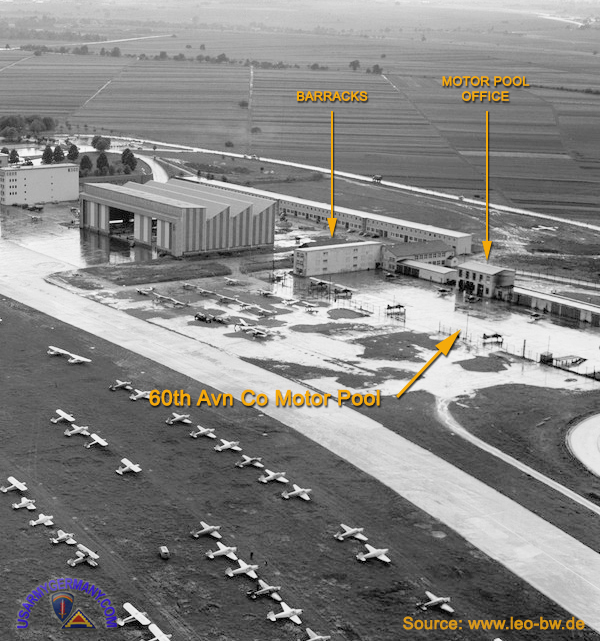 Stuttgart Airport - civilian side: area used by the 60th Avn Co as a motor pool in the 1960s |
|||
| One of your photos (above) shows what appear to be U.S. Army aircraft at the far right of your photo. This does look like what later became the fenced-in motor pool area. I was only over there a few times. The two story building would have been the office area for the motor pool. The three story building to the left in your photo was a barracks. This was definitely used by the small USAF air traffic controller detachment for the military side of the field. This consisted of a few enlisted men (one of whom served as our bartender in the EM club), and a lieutenant. We were always envious of those barracks since the USAF guys had their own private rooms. Buildings 3246 - 3248 were two-story concrete barracks, with a latrine at the end of the first floor. These were apparently built for the Luftwaffe during or before WWII. #3248 was used by the 60th when I first arrived (August 1963), but after only a short period (probably no longer than one month) this was given to a different unit and the 60th EM were moved to the T-3261 quonset huts. As I recall, the other two metal structures (T-3262 and T-3263) were unoccupied the entire 25 months I was stationed there. T-3261 was more or less H-shaped with the latrine in the center, complete with undivided toilets and a shower area consisting of several steel pipes (no shower heads). The barracks areas had plastic windows and were heated by steam radiators controlled by a central facility elsewhere -- probably one of the structures shown in the southeast area. The coal-fueled steam generating plant was operated by German civilians. They went home after midnight which meant for some very cold wake-ups during the winter months. Thanks for maintaining this website. It really brought back the memories. |
|||
| 1965 | |||
| (Source: Email from Paul Cleary) | |||
| In 1965 the Army set up a school at Stuttgart AAF to transition pilots from fixed wing qual to rotary wing. Each Cav outfit in Germany sent 2 UH1's to the school in Stuttgart. I was TDY for 6 mos. We stayed at Nelligen Bks. The school was such a success that they ran a second school at Schleissheim outside of Munich. |
|||
| 1964/65 & 1967/68 | |||
| (Source: Email from R.C. Neeb, Jr.) | |||
| (Click here to read more information and see additional photos from R.C.'s assignment to the 67th Avn Co in the 1960s) The permanent barracks were bldgs #3246, #3247, #3248. As far as I can remember, Hangar #3234 was the 67th Avn Co's Rotary Wing hangar. Hangar #3223 was the 67th Avn Co's Fixed Wing hangar. In the time frame I was there (64-65 , 67-68) there was no 62nd Avn Co. When I returned to Echterdingen in 1967, the 67th Avn was gone (to Nelligen???) Don't know who occupied those bldgs. For the short time I was there I bunked in T-3263. ADDITIONAL INFO There were lots of changes and movements during those years. I moved four times with the 67th. Initially lived in the tin huts (quonset-type), heating system went inop, was moved to Bldg #3247, then due to overcrowding, was moved to Kelly Barracks for awhile, then moved back to the tin huts, and finally to Bldg #3247. See Bldg #3251 (mess hall) - It was a consolidated mess hall but had to have had the best groceries in the US Army at that time. Lots of the EM didn't care for the chow so they ran over to the snack bar or the club and ate. More for me. Always had 2nds and 3rds when roasts (beef or pork), sauerkraut & potatoes were served. Lots of good stews were served too. Pulled a lot of KP in there. Eat & snack all day. Stuttgart produced lots of sauerkraut -- may be the kraut capitol of Germany. Cabbage fields surrounded the airfield. Got real ripe when the "honey wagons" were unloading. |
|||
| 1965 | |||
| 1967-68 | |||
| (Source: Globesecurity.org) | |||
| U.S. Air Forces in Europe (USAFE) took over command of the military airfield and also accoutability for real and installed property from the U.S. Army Europe (USAREUR) on 1 July 1967. USAFE took full responsibility for flight operations, but USAFE and USAREUR jointly supported the airfield according to the terms of an agreement that was signed on 7 April 1967. USAFE designated the 7005th Air Base Squadron to operate the airfield and drew up a base development plan for Fiscal Years 69-72. Under this plan they built apron and taxiway additions on the south side, GCA/TACAN, and telephon exchange, and a VIP lounge.
Although the airfield became an Air Force command, about three-fourth of the military air traffic continued to be from the Army. USAREUR aviation units at the field included 29th Transportation Company (Direct Support), 25th Aviation Company, and the flight sections of Headquaters, VII Corps Artillery; Headquaters, 2nd Support Command; and Headquaters, 34th Signal Batallion. The military facilities were also used by Air Force and Army transient aircraft, particularly those carrying passengers to the major headquaters around Stuttgart. Military Airlift Command has also operated at Echterdingen, landing troops and equipment from the United States there during the annual REFORGER exercises. |
|||
| (Source: STARS & STRIPES, July 11, 1968) | |||
| In 1968, Army engineers (B Co, 94th Engr Bn) initiated a ramp expansion project. The existing ramp is getting an 8-inch layer of concrete and is being lengthened 1,100 feet. With the move of Hqs U.S. European Command (USEUCOM) from Paris, France, to the Stuttgart area (Patch Barracks, Vaihingen) the mission of the Stuttgart AAF has changed. Military flight operations changed markedly in the Spring of 1967 when the Flight Section of Headquaters, USEUCOM moved in. US Army and US Air Force aircraft now stationed at the airfield included multi-engine transports and jets. In addition, a 140-by-120-foot hangar is being constructed to accomodate larger transport airplanes. The existing hangars are all-wood hangars and too small for the larger jet aircraft, such as the C-5 Galaxy. The Stuttgart Army Airfield is unusual in that it does not have its own runway. It depends on the adjacent civilian airport runway for takeoffs and landings. The article also mentions that the installation is now officially called Stuttgart Airfield. Previously it was known as Stuttgart Army Airfield. |
|||
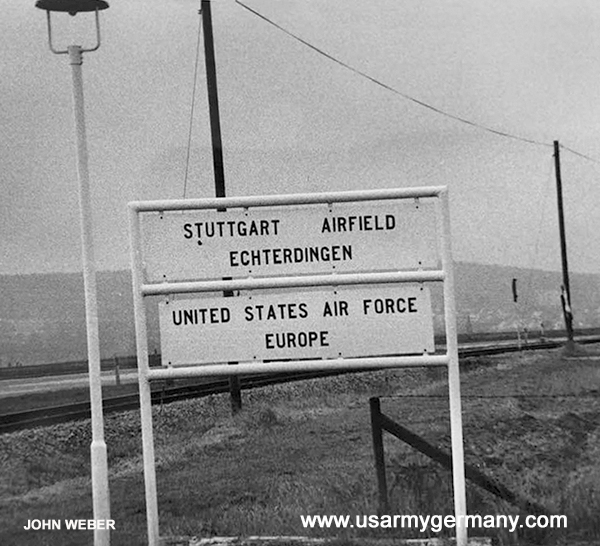 Sign at the main gate, Stuttgart Airfield, 1973 (John Weber) (According to John the military airfield was an Air Force installation until 1974 when it was turned over to the US Army.) |
|||
| 1977 | |||
| (Source: STARS & STRIPES, Feb 23, 1977) | |||
| Webmaster note: I guess the airfield at Stuttgart did not have much in recreational facilities. One visitor from a Worms installation sent a letter to the S&S editor commenting about that lack of facilities. Here is the response from the Director of Personnel and Community Action, HQ Stuttgart Support Command: It is true that there are limited recreation facilities at the Echterdingen Airfield, in that the gymnasium, craft shop and NCO/EM Club are the only recreation facilities available. Considering the factors of the size of the installation at Echterdingen, distance to other facilities and limitations in funds and manpower, it is not deemed feasible to open other recreational facilities at that installation. In addition to the facilities mentioned above, there is a lot available to and for the Echterdingen service members. Kelley Barracks is only three miles away from Echterdingen, and Nellingen is only four miles away. Both installations have Recreation Service facilities readily available. Army shuttle buses run a minimum of twice daily between Echterdingen Airfield and Kelley Barracks. A duty bus between Nellingen and Echterdingen has a permanently assigned bus that is available for many planned off-duty activities. Additionally, units at Echterdingen are included in all of Nellingen's troop athletic leagues. |
|||
| Seventh Army Aviation Training Center | |||
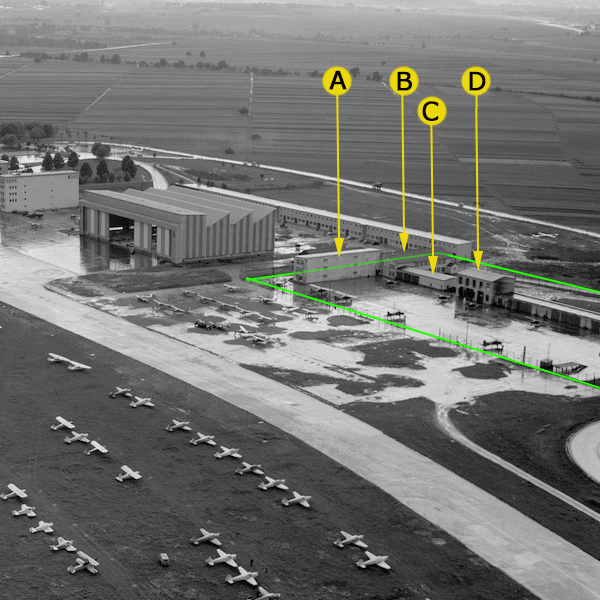 Civilian Site of Stuttgart Airfield, 1957 (Photo source: www.leo-bw.de) ((A) = barracks; (B) = Training Center building with Link trainers?; (C) & (D) = maint buildings) If anyone can provide more details on the location of the billets, admin offices, classrooms and Link trainer room, please contact the webmaster - email link at top of page. |
|||
| 1956 | |||
| (Source: STARS & STRIPES, April 12, 1956) | |||
| The Seventh Army Aviation Training Center is located in a small US Army compound on the civilian side of the Stuttgart Airport. Lt Col Charles A. Wirt is the present commanding officer of the center. The school, established on July 1, 1955, has six objectives: 1.) Increase the instrument flying proficiency of Army aviators, to include qualification and requalification of instrument pilots. 2.) Develop and standardize flight instruction and transition training of Army aviators. 3.) Prepare and conduct instruction in organizational maintenance and supply of Army aircraft and related equipment. 4.) Provide an Army aviation safety board to review reports of Army aircraft accidents. 5.) Prepare for publication appropriate safety reviews, directives and educational literature. 6.) Provide and maintain adequate aircraft and physical facilities to accomplish the assigned mission. Students attending the courses at the center already have had previous aviation training -- they are not there to learn how to fly but to become qualified to instruct other aviators when they get back to their units. The students who are sent to the training center are aviators or mechanics who have been sent to the center for mandatory refresher courses or to take specific courses in the center's curriculum, such as the instructor pilot course or instrument pilot course. Each instructor at the center has two students. When the instructor is out flying with one of the students, the other is on the Link Trainer (ANT-18)a). There are six such simulators (Link trainers) at the 7th Army Aviation Training Center. Those giving the flight simulator or Link tests are German civilians, some former Luftwaffe pilots, who sit at desks with the same instruments as appear in the flight simulator, checking the operation of the instruments by the students and making note of errors. Whatever the student does in the cockpit is reflected on the instruments which the German intructor watches at his desk. The student taking the instrument pilot course comes to the center to achieve a certificate for instrument flying. The instrument pilot is required to take an examination once a year to requalify himself, otherwise his certificate lapses. The same goes for the pilot gaining a certificate as instructor pilot. He must return to the center once a year for refresher training. |
|||
| a) Source: Wikipedia - link ANT-18 The ANT-18 featured rotation through all three axes, effectively simulated all flight instruments, and modeled common conditions such as pre-stall buffet, overspeed of the retractable undercarriage, and spinning. It was fitted with a removable opaque canopy, which could be used to simulate blind flying, and was particularly useful for instrument and navigation training. The ANT-18 consists of two main components. The first major component is the trainer itself. The trainer consists of a wooden box approximating the shape of a cockpit and forward fuselage section, which is connected via a universal joint to a base. Inside the cockpit is a single pilot's seat, primary and secondary aircraft controls, and a full suite of flight instruments. The base contains several complicated sets of air-driven bellows to simulate movement, a vacuum pump which both drives the bellows and provides input to a number of aircraft instruments, and a device known as a Telegon Oscillator, which controls the remaining instruments. The second major component is an external instructor's station, which consists of a large map table, a repeated display of the main flight instruments, and a moving marker known as a "crab." The crab moves across the glass surface of the map table, plotting the pilot's track. The pilot and instructor can communicate with each other via headphones and microphones. |
|||
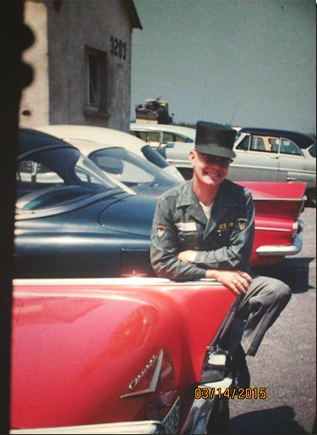 The building number (background) looks like 3203. That was either the barracks or a building nearby. |
|||
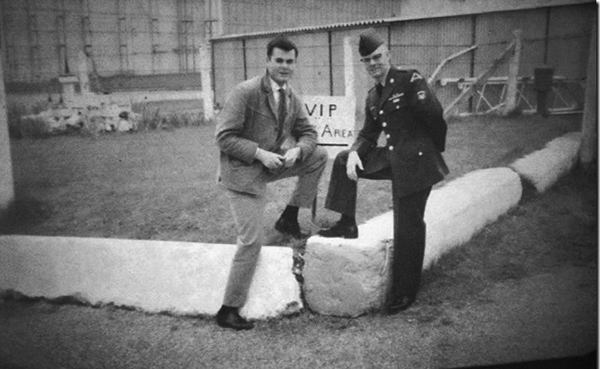 The civilian in the photo with me was Hans Christ, one of our German link trainer instructors |
|||
| 1958 | |||
| (Source: Email from Jimmy C. Kimble) | |||
| I was a Flight Simulator Instructor at the Seventh Army Aviation School from Jan 1958 until Dec 1960 (Stuttgart Airfield). The Barracks and the School Headquarters were located on the Civilian side of the runway. Therefore, we rode a bus to the Mess Hall, which was located on the Military side. Our mission at the Seventh Army Aviation Center was to provide Instrument Qualification training and to train pilots who would then go to units as Instrument Instructors. The School Commander was a short Lt Col named Schirmacher. He was tough. His opening speech to a new class of students was “We can train twenty students at a time. Twenty-five of you were selected to attend. Monday will be a test flight day. Tuesday morning five of you will go back to your units.” The brass threatened to close the school because of the high student failure rate and he told them he would rather see the school closed than to put his name on an Instrument Ticket for a student who might one day kill himself and perhaps others. The ANT-18 simulators we had were made in the 1930s and the students hated them. I believe that is one reason it took so long for the Army to realize the true benefits of simulation. The Generals making the decisions had probably gone through Flight School as young Officers and remembered their experiences with the ANT-18. The student climbed into the cockpit, closed the door, pulled the canopy closed and got instant claustrophobia. If the student allowed the airspeed to drop to the point of a stall, the simulator went into a spin (the cockpit turned round and round very quickly). When a person cannot see outside the cockpit in such a situation, he can become very ill. I have seen students so sick that they could not walk. |
|||
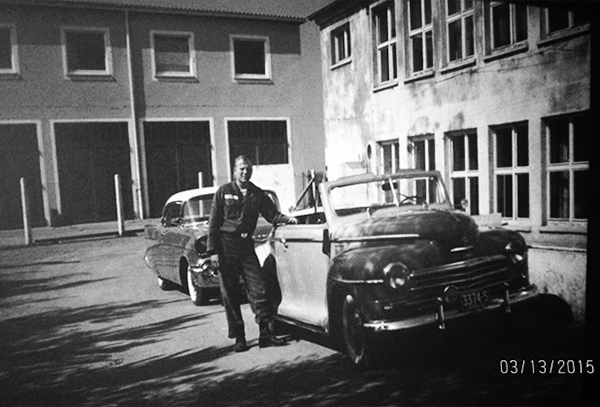 The building next to the convertible is definitely the barracks. The building behind the fence was not a part of the Center. It was being used to develop a ramjet by the Germans. The 57 Chevy was mine. That was a great car. |
|||
| The crew chiefs assigned to the school taxied the aircraft all the way around the airfield to the military side at night and brought them back in the morning. It was so far that sometimes they would fly the planes a few feet off the ground to get them moved quicker. At the time the planes were Birddogs and Beavers. Once, a couple of the crew chiefs got drunk and decided they would show everybody that they could fly so they took off in a birddog (L-19), at night, and flew around awhile. They decided that they would land on a short strip of grass in front of the BOQ. Of course they crashed the aircraft. Not too much damage and they were not hurt badly. Those old aircraft were easily repaired. In a different incident, we were on the bus going to the Mess Hall when we passed an H-13 about to take off (on the Military side). The right skid caught on the PSP and the H-13 was destroyed. Pieces of the blades went everywhere. The pilot got out ok. There were ground school classrooms with training aids. Most of the classes were taught by the Flight Instructors. When I arrived at the Center, the planes we had were the TL-19 (Birddog with a rear seat instrument panel), L-20 Beavers, and I remember that we had at least one L-23 (two engine aircraft) because it landed with the gear up and the story goes that the pilot said that he could not hear the tower telling him the gear was not down for the loud gear warning horn going off. Later, H-19 (very difficult to fly on instruments. Felt like an apple on a long string) and the H-34, a great helicopter for instrument flying. Very stable. Whenever possible, I would ride with an Instructor and they would sometimes let me fly the aircraft. Strangely, I could fly instruments before I could fly VFR. Later, when I attended a civilian flight school, the first takeoff I made was to line up with the center of the runway, roll the throttle up and when the airplane felt like it would fly, I raised the nose two bar widths on the attitude indicator and away we went. I had not even looked outside the cockpit. The flight instructor was dumbstruck. He told me to go around, land, and lets do that again but this time, look outside. |
|||
| (Source: Email from Roy E. David, SUSAATC, 1958-1960) | |||
| I was assigned to SUSAATC, which was Seventh U S Army Aviation Training Center, at Echterdingen Airfield, Stuttgart Germany, as a Crew Chief on a DeHavilland Beaver L-20 from March 1958 thru June 1960. The Company Commander - Captain Victor P Rizzo, 1st Sgt. - M Sgt. VonEssen (sp) , Maintenance Sgt. - Sgt. Robert Acree. We were barracked on the N side, Civilian, of the Airfield and maintained our airplanes on the S, Military, side of the airfield. There is a map of this in your Web Site with the story from Sp.5 Kimble which points out the various buildings and is as I remember it. The flight operations and parachute room for the school were located on the N. side adjacent to our barrack and training rooms. A list of some of the crew chief personnel that I am still in touch with are Henry Hopkins, John Bauer, Norman Jahnke, Kenneth Liesinger Frank Yanda and Motor Pool Sgt. Cosmo Romano. Others serving at that time were Sgt. Cook, Sgt. Fouch, Darrell Hosier, Olivera Chevalier, Sp. 5 Johnston, Sgt. Jarvis, Sp.4 McCoy (Mail Clerk). (Deceased personnel - Denise Rice, Jack Bowman and Elzie Palmer). Also serving with me, but I have been unable to locate, Sgt. Leach, J.L. Legg, Carl Carlson, James Fredericks, Richard Harris, and Kenneth DeHaven. The Air Force had a radio man stationed with us, Sgt. Joe DiPasqua, who maintained the military radios at the civilian tower. The article by Sp.5 Kimble is correct in saying the Barracks were three story with the Link Training center, day room, CO and First Sgt. offices on the first floor and the enlisted barracks on the second and third floor, there was also a kitchen located on the first floor which was never used while I was there except for coffee. Except for the 2nd and 3rd floor end rooms facing the runway which were 4 or 5 man rooms all the rest were 2 man. When I arrived there we were paid in Military Script which had to be exchanged on base for Marks. Without any notice the Script was all called in and all transactions were done in American Dollars. A number of off base German Civilian establishments were left holding script and were out of luck trying to exchange it, since it was against Military regulations to use script off base. At the start of my service on pay day you were never sure how much your pay would be as there were no pay vouchers and if you had been over paid maybe for a couple of periods, when caught, this over payment would be deducted at the next pay period which would make it considerably less. My records may be incomplete but they show Pay Vouchers began in Feb of 1959. The rate of exchange at that time $ 1.00 to four (4) German Marks. To my knowledge during my stay there were never any aircraft accidents associated to SUSAATC. That is a remarkable record considering the number of hours flown by the Instrument Training Pilots. The Link Trainer was used in the schooling for the pilot instrument training. At the completion of their schooling they were required to fly so many consecutive hours under instrument conditions which were flights from Stuttgart to Copenhagen overnight then Hamburg overnight and return to Stuttgart. Other destinations were London Gatwick, Paris Le Barge, Barcelona, Cannes, Cologne and Amsterdam. Other Instructor pilots were, Capt. Freeman Stewart, Capt. Raymond Forehand, Capt. Howard Groth. These certification flights went on continuously every 8 weeks during my tour. My service was a very rewarding experience and one I will never forget. Off post the primary destination was the Krone Gasthaus in Echterdingen. I returned in 1970 for a visit and was very disappointed with the changes that had been made at the airfield and the local building architecture but the Gasthaus was still owned and operated by the same family, Heir Seidel, whom I had a very enjoyable reunion visit. One short funny story if there is time. One day Sp. 4 Palmer & I were in the parachute room which had a main entry and a side door to the Flight Op room. Palmer had just come in from a short flight with Capt. Blunck. One of the guys in the Flight Op room stuck his head in and said, “Palmer, Capt. Blunck wants you to get his parachute out of the plane.” Palmer not realizing Capt. Blunck was still next door responded “ tell Capt. Blunk to get his own *%#@ chute.” Just then Capt. Blunk walked briskly past the main entrance door. A minute later the phone rang, I answered it and said, “ Parachute Room Sp. David speaking”. The reply, “David this is Capt. Blunck, would you please tell Sp. Palmer I would like to see him in my office.” Capt. Blunk returned to the USA on the Geiger and sought me out while aboard ship to help make my trip home a little more bearable. He told me on a number of occasions, that experience with Sp. 5 Palmer was one of the highlights of his tour at SUSAATC. And Palmer later said that Capt. Blunck really wasn’t that tough on him. I went thru Basic Training at Ft. Knox KY, Aircraft Maintenance School at Ft. Eustis VA, and traveled to Europe on the US NS Darby and returned to the US on the USNS Geiger. The information on buildings and facilities is very accurate as I remember. The movie theater hanger I think was Hangar #3217. Our heavy maintenance support group 29th Trans Co I think was housed in hangar #3240. |
|||
| 545th Military Police Platoon | |||
| 1975 | |||
| (Source: Email from Paul Klinko) | |||
| I was at SAAF during the time period 1975 to 1980. We were the S545th Military olice Platoon. Our C.O. was usually a 1st Lt. and we were assigned to Stuttgart Army Airfield, Stuttgart, Germany along side of the 223rd Aviation Battalion and the 73rd MI Company (MOHAWK). |
|||
| Related Links: |
|||
